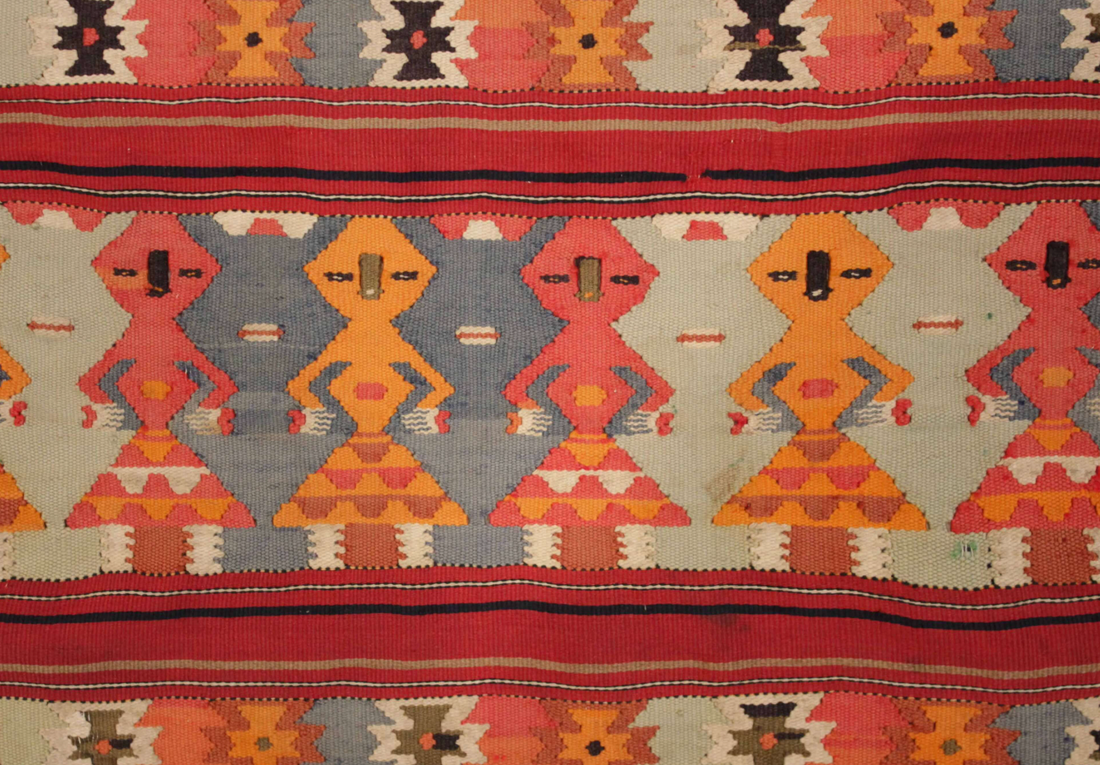
Mixed Media: Woven Abstractions of the Berber Women
Moroccan rugs will never cease to amaze me. After over twenty-five years of hunting and gathering the Maghreb, from the Atlantic coast to the Atlas mountains and the arid Saharan desert, I am still mesmerised by the sheer ingenuity and versatility of Berber textile art. In particular, the last two decades of the previous millennium have witnessed the arrival on the Moroccan scene of previously unknown woven species. Collecting this material, albeit of relatively recent vintage, has allowed for the recording of possibly the last wave of authentic rural weavings arising from a still-genuine indigenous tradition. The photograph taken at ‘circa 2000’ will likely prove to be a very significant one, in that it will document the cut-off point between collectable rugs indicative of the material culture of the Berber people and those which have been woven to satisfy the demands of a growing market.

Image: Rug with Polychrome Squares, Ourika Valley, Central High Atlas, circa 1980. Image above: Pillow Case with Anthropomorphic Figures, Gafsa region, Central Tunisia, circa 1900.
The trend-driven enthusiasm for Moroccan carpets has, however, been the catalyst for the present influx of a singular genre of weavings which had not been previously considered worthy of commercial interest – rugs which had been woven by Berber women for domestic purposes. These are often constructed by employing a range of materials, using the precious wool sparingly, and only when necessary towards the completion of what appear as very personal aesthetic projects. As an alternative to wool, these women utilise a plethora of materials, from rags to riches, often as a textural ingredient but also as a source of improbable colour. The combination of these fibres, which were the only ones available, reveals a pronounced artistic sensibility in expressing an intimate language, one that would have been significant only for herself or within the confines of a family or a tribe. Yet it’s truly endearing to be allowed within, to share in the arcane, personal vision and to feel the purity of its manifestation as a work of woven art. Aside from displaying the most ingenious fibre combinations known to the weaving practice, these also function as carriers of a vestigial language, expressed through abstract forms intimately connected to the Neolithic rock carvings present in some areas of the Maghreb.

Image: Rug with Polychrome Squares and Heart-shaped Motifs, Western Middle Atlas, Morocco, circa 1980.
I have chosen to present a selection of my most significant acquisitions of these weavings, including a cluster of earlier rugs as an indication of the continuity of its discourse. While the older examples occasionally offer a more mature attitude, as dictated by the need for economic use of the wool supply, along with larger formats destined for more high-visibility displays, the works of the younger generation of Moroccan women have been equally vital in continuing the tradition by venturing into more textural grounds, evolving the language from its earlier substrate into symbols of their time.
Text courtesy of Alberto Levi
See the online exhibition from the comfort of your own home:
www.albertolevi.com/exhibitions/woven-abstractions-of-berber-women

Image: Rug with Polychrome Squares, Ourika Valley, Central High Atlas, circa 1980. Image above: Pillow Case with Anthropomorphic Figures, Gafsa region, Central Tunisia, circa 1900.
The trend-driven enthusiasm for Moroccan carpets has, however, been the catalyst for the present influx of a singular genre of weavings which had not been previously considered worthy of commercial interest – rugs which had been woven by Berber women for domestic purposes. These are often constructed by employing a range of materials, using the precious wool sparingly, and only when necessary towards the completion of what appear as very personal aesthetic projects. As an alternative to wool, these women utilise a plethora of materials, from rags to riches, often as a textural ingredient but also as a source of improbable colour. The combination of these fibres, which were the only ones available, reveals a pronounced artistic sensibility in expressing an intimate language, one that would have been significant only for herself or within the confines of a family or a tribe. Yet it’s truly endearing to be allowed within, to share in the arcane, personal vision and to feel the purity of its manifestation as a work of woven art. Aside from displaying the most ingenious fibre combinations known to the weaving practice, these also function as carriers of a vestigial language, expressed through abstract forms intimately connected to the Neolithic rock carvings present in some areas of the Maghreb.

Image: Rug with Polychrome Squares and Heart-shaped Motifs, Western Middle Atlas, Morocco, circa 1980.
I have chosen to present a selection of my most significant acquisitions of these weavings, including a cluster of earlier rugs as an indication of the continuity of its discourse. While the older examples occasionally offer a more mature attitude, as dictated by the need for economic use of the wool supply, along with larger formats destined for more high-visibility displays, the works of the younger generation of Moroccan women have been equally vital in continuing the tradition by venturing into more textural grounds, evolving the language from its earlier substrate into symbols of their time.
Text courtesy of Alberto Levi
See the online exhibition from the comfort of your own home:
www.albertolevi.com/exhibitions/woven-abstractions-of-berber-women
